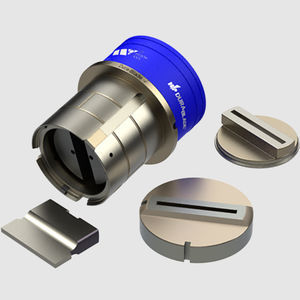
- Products
- Punch holder
- WILSON TOOL
Punch holder 14759_BSE
Add to favorites
Compare this product
Description
The best style of die for punching holes of less than .236” (6mm) diameter in mild steel and stainless steel, or less than .472” (12mm) diameter in aluminum. However, use of this style of die can result in slug pulling.
Negative Taper:
Although the taper is only .0005” (0.01mm), this is enough to help squeeze and hold the slug as it is pushed down into the die land, thus helping to prevent slug pulling. Negative taper is not recommended for punching aluminum or plastic because of slug packing.
Slug Hugger 2® Dies:
This is the only guaranteed method of stopping slug pulling and is especially recommended for use with modern punch presses due to the high punching speed. The high speed of today’s punch presses has increased the problem of slug pulling. The quicker punching speeds can cause a vacuum to form between the punch and slug, which pulls the slug out of the die as the punch retracts. To resolve this problem, Wilson Tool has developed Slug Hugger dies. A Wilson Tool innovation, Slug Hugger dies have specially designed “bumps” on the inside of the die land, which “hug” the slug and ensure that it stays within the die. This style of die is individually designed with each order to suit the material type and thickness to be punched. Slug Hugger dies also offer the advantage of stopping slugs from spinning within the die. Spinning slugs can cause the sheet to be pulled from the clamps causing sheet and tool damage.
Slug Hugger 2® dies must be ordered punch size + clearance. .006” minimum clearance.
Neg/Pos Taper:
An hourglass shaped taper. The die is slightly negative as the slug enter, narrows to prevent the slug from pulling back up and then tapers positive.
Catalogs
No catalogs are available for this product.
See all of WILSON TOOL‘s catalogs*Prices are pre-tax. They exclude delivery charges and customs duties and do not include additional charges for installation or activation options. Prices are indicative only and may vary by country, with changes to the cost of raw materials and exchange rates.



































